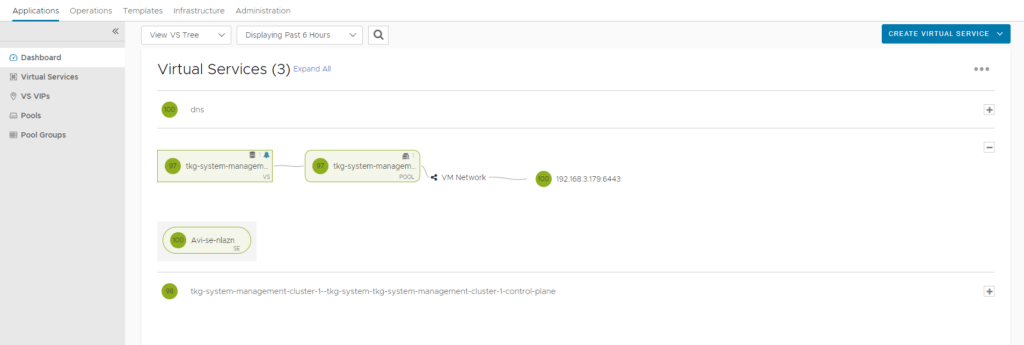Now that the management cluster has been deployed, we can deploy our first guest cluster.
This is done via another yaml file and some cli commands.
Deploy Guest Cluster
Prepare the guest-cluster.yaml file
The guest cluster will be deployed similarly to how you can deploy the management cluster via the CLI, using a yaml file. Here is an example yaml file that works for me.
1 2 3 4 5 6 7 8 9 10 11 12 13 14 15 16 17 18 19 20 21 22 23 24 25 26 27 28 29 30 31 32 33 34 35 36 37 38 39 40 41 42 43 44 45 46 47 48 49 50 51 52 53 54 55 56 57 58 59 60 61 62 63 64 65 | AVI_CA_DATA_B64: LS0........Cg==AVI_CLOUD_NAME: vcenterAVI_CONTROL_PLANE_HA_PROVIDER: "true"AVI_CONTROLLER: avi-controller.home.labAVI_DATA_NETWORK: Data-vlan7AVI_DATA_NETWORK_CIDR: 192.168.7.0/24AVI_ENABLE: "true"AVI_LABELS: ""AVI_MANAGEMENT_CLUSTER_VIP_NETWORK_CIDR: 192.168.7.0/24AVI_MANAGEMENT_CLUSTER_VIP_NETWORK_NAME: Data-vlan7AVI_PASSWORD: <encoded:TsdfsdfsdfEh>AVI_SERVICE_ENGINE_GROUP: Default-GroupAVI_USERNAME: adminCLUSTER_CIDR: 100.96.0.0/11CLUSTER_NAME: guest-cluster-1CLUSTER_PLAN: devENABLE_AUDIT_LOGGING: "false"ENABLE_CEIP_PARTICIPATION: "false"ENABLE_MHC: "true"IDENTITY_MANAGEMENT_TYPE: noneINFRASTRUCTURE_PROVIDER: vsphereLDAP_BIND_DN: ""LDAP_BIND_PASSWORD: ""LDAP_GROUP_SEARCH_BASE_DN: ""LDAP_GROUP_SEARCH_FILTER: ""LDAP_GROUP_SEARCH_GROUP_ATTRIBUTE: ""LDAP_GROUP_SEARCH_NAME_ATTRIBUTE: cnLDAP_GROUP_SEARCH_USER_ATTRIBUTE: DNLDAP_HOST: ""LDAP_ROOT_CA_DATA_B64: ""LDAP_USER_SEARCH_BASE_DN: ""LDAP_USER_SEARCH_FILTER: ""LDAP_USER_SEARCH_NAME_ATTRIBUTE: ""LDAP_USER_SEARCH_USERNAME: userPrincipalNameOIDC_IDENTITY_PROVIDER_CLIENT_ID: ""OIDC_IDENTITY_PROVIDER_CLIENT_SECRET: ""OIDC_IDENTITY_PROVIDER_GROUPS_CLAIM: ""OIDC_IDENTITY_PROVIDER_ISSUER_URL: ""OIDC_IDENTITY_PROVIDER_NAME: ""OIDC_IDENTITY_PROVIDER_SCOPES: ""OIDC_IDENTITY_PROVIDER_USERNAME_CLAIM: ""OS_ARCH: amd64OS_NAME: photonOS_VERSION: "3"SERVICE_CIDR: 100.64.0.0/13TKG_HTTP_PROXY_ENABLED: "false"TKG_IP_FAMILY: ipv4VSPHERE_CONTROL_PLANE_DISK_GIB: "40"VSPHERE_CONTROL_PLANE_ENDPOINT: ""VSPHERE_CONTROL_PLANE_MEM_MIB: "8192"VSPHERE_CONTROL_PLANE_NUM_CPUS: "2"VSPHERE_DATACENTER: /vSAN DatacenterVSPHERE_DATASTORE: /vSAN Datacenter/datastore/vsanDatastoreVSPHERE_FOLDER: /vSAN Datacenter/vm/tkgmVSPHERE_INSECURE: "true"VSPHERE_NETWORK: /vSAN Datacenter/network/VM NetworkVSPHERE_PASSWORD: <encoded:Tsdfsdfsdfsdfsdf>VSPHERE_RESOURCE_POOL: /vSAN Datacenter/host/vSAN Cluster/ResourcesVSPHERE_SERVER: vcenter.home.labVSPHERE_SSH_AUTHORIZED_KEY: ssh-rsa AAA........vw== admin@home.labVSPHERE_TLS_THUMBPRINT: ""VSPHERE_USERNAME: administrator@vsphere.localVSPHERE_WORKER_DISK_GIB: "40"VSPHERE_WORKER_MEM_MIB: "8192"VSPHERE_WORKER_NUM_CPUS: "2" |
Switch to Management Context
If you just deployed the guest cluster then you should be fine, but if you ever need to switch context back to the management cluster, you can use these commands:
1 2 3 | tanzu management-cluster kubeconfig get --admin......some output, will give you the command below......kubectl config use-context management-cluster-1-admin@management-cluster-1 |

Create Guest Cluster
1 | tanzu cluster create -f /home/matt/guest-cluster.yaml |


Validate the Guest Cluster
Using the tanzu cli, you can run a command to view the cluster status:
1 | tanzu clusters get guest-cluster-1 |


Switch to Guest Cluster Context
Similarly to how we switched context to the management cluster, we can do the same for the guest cluster.
1 2 3 4 | tanzu cluster kubeconfig get guest-cluster-1 --admin......some output, will give you the command below......kubectl config use-context guest-cluster-1-admin@guest-cluster-1kubectl get pods -A |
